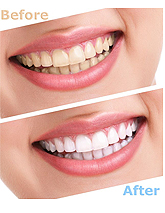Bleaching & Veneers
Bleaching
Bleaching (teeth whitening) is an easy, non-invasive procedure used to restore teeth colour to their brightest white.
There are a number of teeth bleaching systems available, from over the counter whitening products, to the most effective, professionally applied whitening. All systems are based on the application of hydrogen peroxide like chemicals that destroy the stains accumulated in the natural enamel of the teeth over time. The dentist supervised bleaching yields superior results because it uses a higher concentration of whitening agents provided in safe professional grade whitening gel preparations.

Bleaching will bring the teeth to their original shade, but will not change their natural colour. Bleaching is not permanent. Stains from foods and drinks will accumulate over time and can darken the enamel again. Touch-ups will be needed after a certain time, depending upon your intake of stain causing foods and drinks. For some patients a touch-up becomes necessary after 3-6 months, for others after a few years.
Bleaching only whitens natural tooth enamel. Any restorations, such as white fillings or crowns will not be affected. It is important that your teeth are assessed prior to bleaching to determine if any such restorations may need replaced after bleaching so they match the newly bleached teeth.
The most popular dentist supervised teeth bleaching consists in application of bleaching gel held in a custom made "bleaching tray" which is worn over the teeth for a short time every the day for a maximum of two weeks. The trays are custom made in office to your mouth, and professional grade bleaching gel and instruction will be provided to you.
The custom made bleaching trays can be used later for touch ups as long as there are no major changes in the shape or position of your teeth.
Veneers
Veneers are thin "facings" glued permanently over the lip-side of front teeth for cosmetic reasons. Veneers are used to improve the shade or shape of front teeth, or close gaps between teeth and improve the esthetics of the smile.
There are two main types of veneers: Porcelain (lab fabricated or "indirect") veneers and composite ("chair side" or "direct') veneers. The Lab Fabricated ("indirect') veneers are thin porcelain "facings" that are made in the dental laboratory from impressions of your front teeth. Two appointments a few weeks apart are usually needed for indirect veneers. In the first appointment the teeth to receive veneers may need to be shaped by the dentist, when a thin layer of your tooth is shaven off to allow a good fit of the veneer, then an impression of the shaped teeth is made and sent to the dental lab. In the second appointment the dentist checks the fit and esthetics of the veneers on your teeth before permanently cementing them.
The "chair side" ("direct") veneers are done in only one visit, and involve placing of composite material over the teeth needing improvement, to improve the shape, size or mask the shade of an unsightly tooth or teeth.
All veneers have a limited lifespan and will need to be replaced at some point.
Porcelain veneers provide superior esthetics and can last longer than the composite veneers, but composite veneers application is a more conservative and strictly reversible procedure since there is no need of modifying the original tooth shape.
There are instances when one or the other type of veneer may be more appropriate, depending on specific conditions or goals, and the options will be discussed with you.
- Low Radiation Digital Radiogaphs
- Intraoral Camera
- Relaxation and Sedation Dentistry
- New Patients Welcome
- Latex Free Office
- Emergencies Welcome
